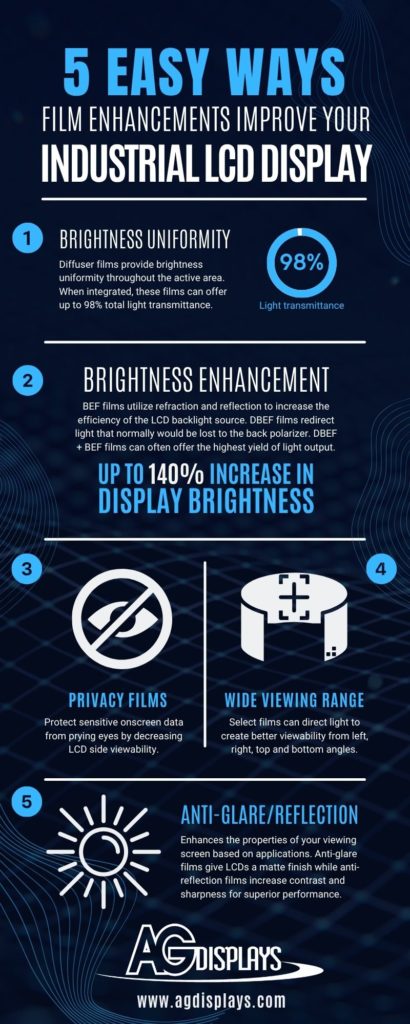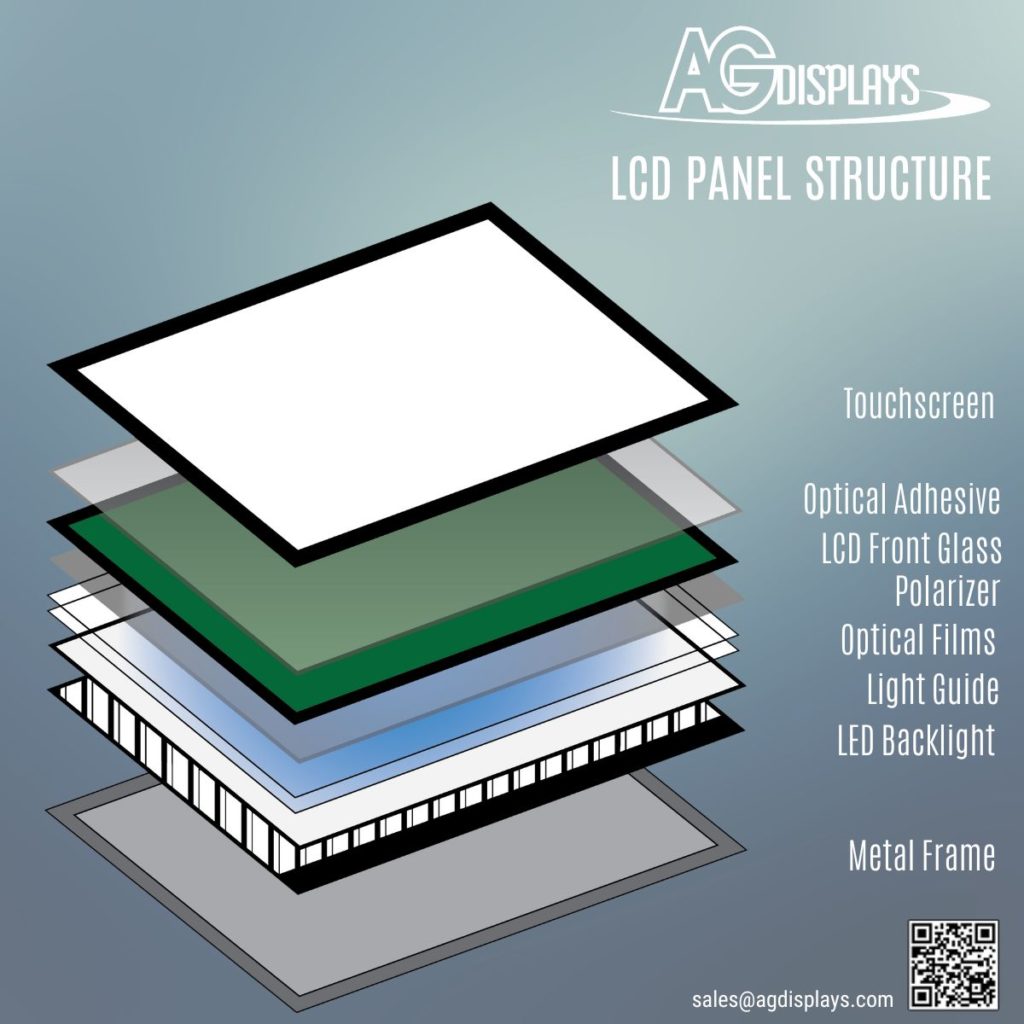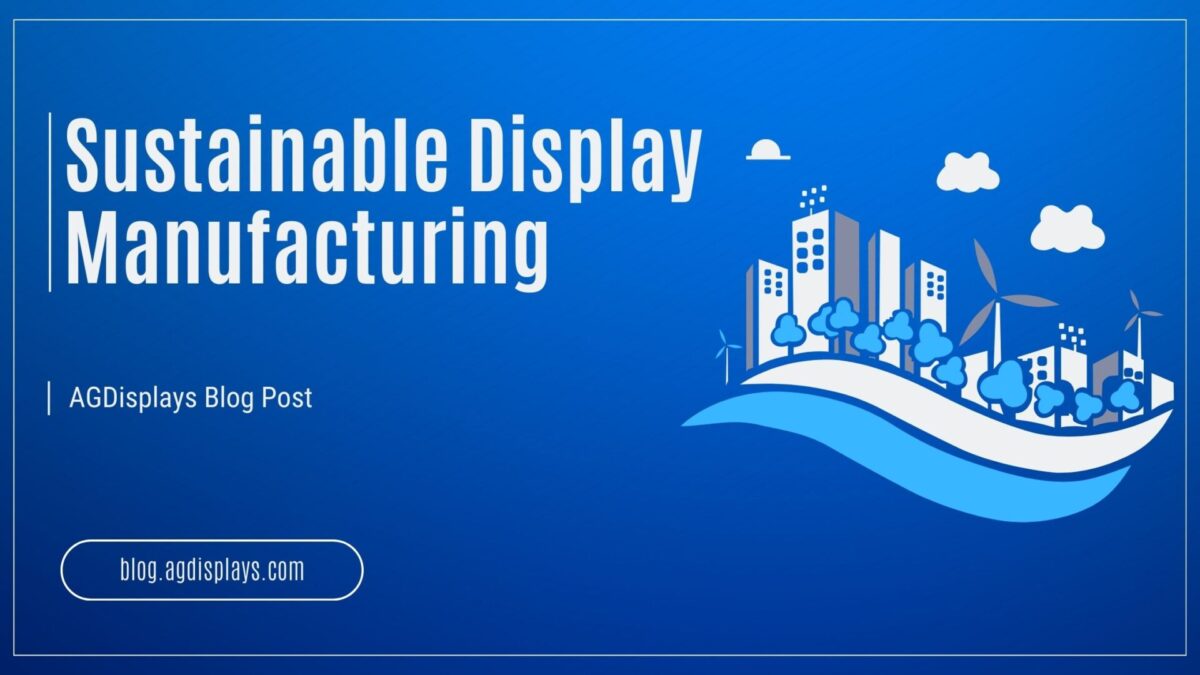In the high-stakes world of industrial operations—spanning bustling factory floors, sun-scorched oil rigs, sterile medical labs, and rugged military outposts—Liquid Crystal Displays (LCDs) are the unsung heroes delivering critical data that powers efficiency, ensures safety, and maintains uptime. These displays underpin Human-Machine Interfaces (HMIs), diagnostic equipment, navigation systems, and more. Yet, as time marches on, even the most durable LCDs begin to falter, with fading clarity, weakened contrast, and diminished readability threatening their effectiveness. The root cause often lies in a subtle but essential component: the polarizer.
At AGDisplays, we’ve witnessed the impact of polarizer degradation across industries, and we’ve developed expert replacement services to restore display performance without the expense of a full replacement. This blog delves into the critical role of polarizers, the harsh industrial conditions that wear them down, how to identify the need for replacement, and why AGDisplays is the trusted partner to revive your aging displays. We’ll also explore advanced techniques, additional enhancements, and real-world success stories to illustrate the transformative power of this solution.

What Are Polarizers and Why Do They Matter?
Polarizers are the backbone of LCD functionality, acting as optical filters that control light to create the images we see. Picture them as the polarized lenses in high-end sunglasses, selectively allowing light waves aligned in a specific direction to pass through while blocking others. In an LCD, two polarizers play distinct roles:
- Rear Polarizer: Positioned behind the liquid crystal layer, it aligns light emitted from the backlight into a uniform orientation, setting the stage for image formation.
- Front Polarizer: Located at the screen’s surface, it filters this light based on the liquid crystals’ orientation, producing the final visible image with defined contrast and color.
This dual-layer system is what enables the sharp, readable displays critical for industrial use. However, when polarizers degrade, the results are immediate and detrimental: images lose definition, colors distort, and glare overwhelms the screen. In environments where precision is paramount—such as a surgeon relying on a diagnostic display or a pilot navigating by cockpit screens—this degradation isn’t just a nuisance; it’s a safety concern. Understanding their function underscores why maintaining their condition is vital for long-term display performance.
What Damages Polarizers in Industrial Environments?
Polarizers, though engineered for durability, are thin plastic films vulnerable to the relentless stresses of industrial settings. These environments accelerate wear, leading to performance issues that can halt operations. Here are the primary culprits:
- UV Exposure: Outdoor displays, such as those in transportation hubs or oil fields, face constant sunlight, causing yellowing, cracking, and film decay over time.
- Heat and Humidity: Factories, marine vessels, and unventilated enclosures subject polarizers to high temperatures and moisture, resulting in warping, shrinking, or delamination.
- Chemical and Physical Stress: Harsh cleaning agents, solvents, or accidental scratches from tools or debris erode protective coatings, damaging the film’s integrity.
- Natural Aging: Even in controlled indoor settings like healthcare facilities, polarizers degrade naturally as their polymer structure breaks down, typically becoming noticeable after 5–10 years of use.
The good news? The LCD panel beneath the polarizer often remains functional, making targeted replacement a smart alternative to discarding the entire unit. This resilience is what makes polarizer replacement a cost-effective lifeline for aging displays.
How to Know When Your Polarizer Needs Replacing
Polarizer degradation doesn’t always signal a complete display failure, but it can render screens nearly unusable for their intended purpose. Here are the key indicators to watch for:
- Foggy or Washed-Out Appearance: Text and graphics lose sharpness, making data interpretation difficult—especially in high-stakes monitoring tasks.
- Faded or Uneven Colors: Distorted hues or edge tints (yellow, brown, or purple) suggest polarizer wear, a critical issue for color-sensitive applications like medical imaging.
- Excessive Glare or Reflections: In bright conditions, reflections obscure content, a common problem for outdoor or well-lit industrial settings.
- Physical Damage: Scratches, bubbling, or peeling on the surface point to abrasion or chemical exposure, further degrading visibility.
- Poor Daylight Readability: Screens become illegible under sunlight, a frequent complaint in field operations or transportation environments.
If your display powers on, responds to inputs, and functions electronically but exhibits these visual flaws, the polarizer is likely the culprit. Early detection allows for timely intervention, preventing minor issues from escalating into major disruptions.

AGDisplays’ Expert Polarizer Replacement Process
Replacing a polarizer is a delicate task requiring precision, specialized tools, and industry expertise—qualities AGDisplays brings to every project. Our proven process ensures your display is restored efficiently and effectively:
- Detailed Inspection: Our technicians conduct a thorough assessment to confirm polarizer damage (front, rear, or both) and check for related issues like backlight degradation or touchscreen wear.
- Safe Removal: Using advanced solvents and controlled heat, we remove the old polarizer without scratching the LCD glass or leaving adhesive residue, preserving the panel’s integrity.
- Custom Film Application: We select from a range of high-performance polarizer films—anti-glare, high-contrast, UV-resistant, or sunlight-readable—cut precisely and applied in our cleanroom facilities to match your display’s specifications.
- Comprehensive Testing: Each unit undergoes rigorous testing for brightness, contrast, color accuracy, and uniformity, ensuring it meets or exceeds original performance standards before returning to service.
This meticulous approach, supported by our state-of-the-art cleanrooms and skilled technicians, delivers consistent results for displays of all sizes and applications, from compact control panels to large industrial monitors.
The Advantages of Polarizer Replacement Over Full Display Swaps
Opting for polarizer replacement instead of a complete display overhaul offers compelling benefits, especially for industries balancing performance and budget:
- Significant Cost Savings: Replacement costs a fraction of a new industrial display, particularly for custom or legacy systems where compatible units are rare or expensive.
- Minimal Downtime: Our rapid service minimizes operational interruptions, avoiding the delays of sourcing and integrating new displays.
- Like-New Performance: A fresh polarizer restores clarity, contrast, and readability, often matching or surpassing the original display’s quality.
- No Redesign Challenges: Retain your existing housing and system compatibility, eliminating the need for costly engineering adjustments.
- Eco-Friendly Outcome: Extending display life reduces e-waste, aligning with sustainability goals and corporate responsibility initiatives.
This approach also pairs seamlessly with other refurbishment services, such as backlight upgrades or optical bonding, to fully rejuvenate your display.
Industries That Benefit Most from Polarizer Replacement
Certain industrial applications face heightened exposure to polarizer-damaging conditions, making replacement a critical maintenance strategy:
- Outdoor Signage and Kiosks: Constant UV and weather exposure degrade polarizers, impacting visibility.
- Oil and Gas Equipment: Harsh sunlight, dust, and chemicals demand durable optical solutions.
- Military and Aerospace Systems: Extreme altitudes, temperatures, and vibrations test display resilience.
- Medical Diagnostics: Precise color and contrast are essential for accurate diagnoses.
- Factory Automation: Heat, vibration, and chemical exposure challenge display longevity.
- Marine Navigation Displays: Saltwater, humidity, and UV rays accelerate wear.
- Construction and Mining Vehicles: Rugged conditions require robust optical performance.
In these high-risk settings, regular polarizer checks and replacements ensure displays remain reliable under pressure.

Upgrade Opportunities During Replacement
Polarizer replacement opens the door to enhance your display beyond its original state:
- Anti-Glare/Anti-Reflective Coatings: Improve readability in bright or outdoor environments.
- UV-Resistant Films: Prolong polarizer life in sun-heavy applications.
- Optical Bonding: Enhance durability and reduce reflections for rugged use.
- EMI Shielding: Protect sensitive systems in defense or medical contexts.
- Touchscreen Compatibility: Maintain or upgrade touch functionality without losing sensitivity.
These enhancements ensure your display not only recovers but also adapts to modern demands, offering a competitive edge in performance and durability.
Real-World Success Stories
The practical impact of polarizer replacement shines through in real-world examples:
- Manufacturing Turnaround: A car manufacturer reported fading HMIs slowing their assembly line. AGDisplays replaced the polarizers, restoring visibility and boosting production efficiency within days.
- Healthcare Precision: A hospital’s diagnostic displays showed color shifts, risking misdiagnosis. Our replacement service revived their screens, ensuring accurate patient imaging and compliance with medical standards.
- Oil and Gas Resilience: An oil company faced unreadable field unit screens due to yellowing polarizers under intense sunlight. We replaced over 200 units with UV-resistant, high-contrast films and anti-glare coatings, saving tens of thousands and improving field visibility without redesigning enclosures.
- Transportation Upgrade: An airport’s passenger information displays suffered glare issues, confusing travelers. Our polarizer replacement, paired with anti-reflective coatings, restored clarity and enhanced user experience.
These cases demonstrate how AGDisplays turns display challenges into opportunities for operational success.
Technical Insights: Polarizer Materials and Innovations
For those keen on the technical side, polarizer replacement involves more than swapping films—it leverages cutting-edge materials. Traditional polarizers use polyvinyl alcohol (PVA) with iodine staining, but modern options include:
- High-Contrast Films: Boost contrast ratios for sharper images, ideal for low-light settings.
- Sunlight-Readable Films: Incorporate additives to combat UV damage, extending outdoor life.
- Circular Polarizers: Reduce reflections in specialty applications like wearable displays or curved screens.
AGDisplays stays ahead by sourcing these advanced films, ensuring replacements match or exceed original performance while addressing specific environmental challenges.
Best Practices for Polarizer Maintenance
To maximize the benefits of replacement and prevent future issues, consider these maintenance tips:
- Regular Inspections: Schedule visual checks every 6–12 months to catch early signs of degradation.
- Protective Enclosures: Use sealed housings to shield displays from moisture, dust, and UV light.
- Gentle Cleaning: Avoid harsh chemicals; use manufacturer-approved cleaners to preserve polarizer coatings.
- Environmental Monitoring: Install sensors to track temperature and humidity, alerting you to conditions that accelerate wear.
- Proactive Replacement Plans: Partner with AGDisplays to forecast polarizer lifespan and schedule replacements during routine maintenance.
These practices extend display life and reduce unexpected failures, keeping your operations on track.
Why AGDisplays Leads the Way
AGDisplays stands out as the go-to partner for polarizer replacement, backed by:
- Unmatched Expertise: Our technicians bring years of experience in display refurbishment and enhancement.
- Customized Approach: Solutions are tailored to your industry, from healthcare to heavy industry.
- Advanced Facilities: Cleanrooms and testing equipment ensure top-quality outcomes.
- Proven Track Record: We’ve restored displays for clients across sectors, delivering reliability and value.
Our commitment is to keep your displays performing at their best, supporting your business goals with every replacement.
Restore, Don’t Replace—Contact AGDisplays Today
When your industrial display shows signs of aging—foggy screens, distorted colors, or excessive glare—don’t assume it’s time for a full replacement. Polarizer replacement offers a fast, affordable way to revive clarity, enhance usability, and extend equipment life. With AGDisplays’ expertise, you can trust that your displays will meet the demands of even the toughest environments.
Ready to protect your investment and maintain operational excellence? Contact AGDisplays today, or visit our website to learn how our polarizer replacement services can transform your aging displays. Let’s keep your systems running strong.















